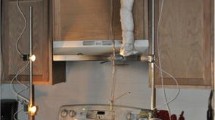Abstract
Cooking equipment is involved in nearly half of home fires in the United States, with cooktop fires the leading cause of deaths and injuries in cooking-related fires. In this study, we evaluate 16 electrochemical, optical, temperature and humidity sensors, placed in the cooktop exhaust duct, for use in predicting and preventing cooktop ignition. The sensors were evaluated in a series of 60 experiments conducted in a mock kitchen. Experiments covered a broad range of conditions, including both unattended cooking and normal cooking scenarios, where 39 experiments led to auto-ignition. The experiments involved a variety of cooking oils and foods and were conducted using either an electric coil cooktop, gas-fueled cooktop, or electric oven. The sensor data collected in the experiments were used in two types of analysis, threshold analysis and neural-network analysis, to estimate the performance of the sensors for predicting ignition and ignoring normal cooking conditions. The combined information from multiple sensors was evaluated in sensor ratios with threshold analysis, and in the neural-network models developed using selected pairs of sensor inputs. Some of the multiple-sensor cases performed as well as or better than the individual sensor thresholds and individual sensor models. Consistently across threshold and machine learning analysis, the best performing sensor was the sensor measuring volatile organic compounds. This sensor was also included in all of the best performing sensor ratios and machine learning models.








Similar content being viewed by others
Data Availability
The full data set will be published and freely accessible via https://doi.org/10.18434/M32171.
Code Availability
Threshold analysis was done using R https://www.r-project.org/. Machine learning was done with open-source TensorFlow as the application program interface (API).
Notes
Further research may be needed to characterize the long-term performance of a sensor system exposed to a range of typical cooking scenarios and kitchen conditions.
References
Ahrens M (2017) Home fires involving cooking equipment. National Fire Protection Association, Quincy, MA
Underwriter’s Laboratory, Northbrook, IL (2014) UL 858 Standard for Household Electric Ranges. https://standardscatalog.ul.com/standards/en/standard_858_16
Gottuk DT, Peatross MJ, Roby RJ, Beyler CL (2002) Advanced fire detection using multi-signature alarm algorithms. Fire Saf J 37(4): 381.
Cestari LA, Worrell C, Milke JA (2005) Advanced fire detection algorithms using data from the home smoke detector project. Fire Saf J 40(1): 1. https://doi.org/10.1016/j.firesaf.2004.07.004. http://linkinghub.elsevier.com/retrieve/pii/S0379711204000682
Gottuk DT, Wright MT, Wong JT, Pham HV, Rose-Pehrson SL, Hart S, Hammond M, Williams FW, Tatem PA, Street TT (2002) Prototype early warning fire detection system: test series 4 results. Interim Report NRL/MR/6180-02-8602, Naval Research Laboratory
Johnsson EL (1998) Study of technology for detecting pre-ignition conditions of cooking-related fires associated with electric and gas ranges and cooktops, Final Report. NIST Internal Report NISTIR 5950, National Institute of Standards and Technology, Gaithersburg, MD
Johnsson E, Zarzecki M (2017) 16th International conference on automatic fire detection (AUBE ’17) and suppression, detection and signaling research and applications conference (SUPDET 2017)
Jain A, Nyati P, Nuwal N, Ansari A, Ghoroi C, Ghandi P (2014) Pre-detection of kitchen fires due to auto-ignition of cooking oil and LPG leakage in Indian kitchens. Fire Saf Sci 11: 1285
Ash M (2016) Edible fats and oils: U.S. Supply and disappearance, 2002/03-2015/16. Tech. Rep. 89002, Economic Research Service, United States Department of Agriculture. http://usda.mannlib.cornell.edu/MannUsda/viewDocumentInfo.do?documentID=1290
Cleary TG (2016) A study on the performance of current smoke alarms to the new fire and nuisance tests prescribed in ANSI/UL 217-2015. Tech. Rep. NIST TN 1947, National Institute of Standards and Technology, Gaithersburg, MD. https://doi.org/10.6028/NIST.TN.1947
Underwriter’s Laboratory, Northbrook, IL (2015) UL/ANSI 217 standard for smoke alarms. https://standardscatalog.ul.com/standards/en/standard_217_8
Dinaburg JB, Gottuk DT (2014) Development of standardized cooking fires for evaluation of prevention technologies: data analysis. Tech. Rep. NIST GCR 15-917-36, National Institute of Standards and Technology. https://doi.org/10.6028/NIST.GCR.15-917-36
United States Department of Agriculture, Food Safety and Inspection Service (2019) Safe Minimum Internal Temperature Chart. https://www.fsis.usda.gov/safetempchart
United States Department of Agriculture, Food Safety and Inspection Service (2013) Deep Fat Frying and Food Safety. https://www.fsis.usda.gov/wps/portal/fsis/topics/food-safety-education/get-answers/food-safety-fact-sheets/safe-food-handling/deep-fat-frying-and-food-safety/ct_index
United States Department of Agriculture, Food Safety and Inspection Service (2013) Bacon and Food Safety. https://www.fsis.usda.gov/wps/portal/fsis/topics/food-safety-education/get-answers/food-safety-fact-sheets/meat-preparation/bacon-and-food-safety/ct_index
M.H. Group (2019) Meat Temperatures Chart (2019). https://www.marthastewart.com/270074/meat-temperatures-chart
Mensch AE, Hamins A, Markell K (2020) Time series data from sensors in the duct above a kitchen cooktop during normal cooking and ignition conditions. https://doi.org/10.18434/M32171
Funding
The project was funded internally by the National Institute of Standards and Technology.
Author information
Authors and Affiliations
Contributions
Conceptualization: AH, AM; material preparation & data collection: AH, AM, KM; data analysis: KM, AM; WCT, JL, CY, MK; original draft preparation: AM; and All authors contributed to review and editing.
Corresponding author
Ethics declarations
Conflict of interest
There are no conflicts of interest.
Additional information
Publisher's Note
Springer Nature remains neutral with regard to jurisdictional claims in published maps and institutional affiliations.
Certain commercial equipment, instruments, or materials are identified in this paper in order to specify the procedures adequately. Such identification is not intended to imply recommendation or endorsement by the National Institute of Standards and Technology, nor is it intended to imply that the materials or equipment identified are necessarily the best available for the purpose.
Rights and permissions
About this article
Cite this article
Mensch, A.E., Hamins, A., Tam, W.C. et al. Sensors and Machine Learning Models to Prevent Cooktop Ignition and Ignore Normal Cooking. Fire Technol 57, 2981–3004 (2021). https://doi.org/10.1007/s10694-021-01112-2
Received:
Accepted:
Published:
Issue Date:
DOI: https://doi.org/10.1007/s10694-021-01112-2




